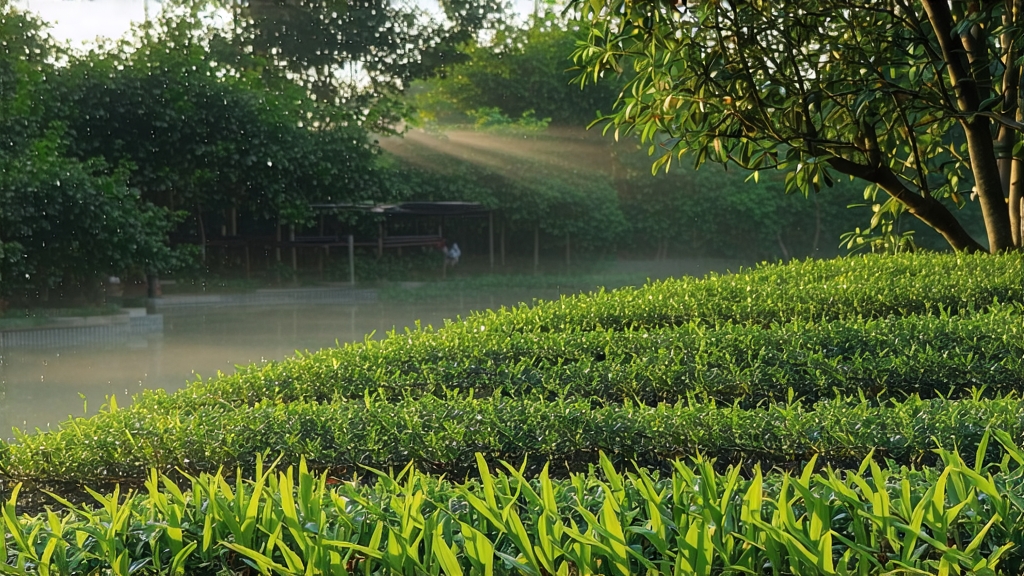
Biluochun, whose name literally means “Green Snail Spring,” is one of China’s ten most celebrated teas, yet it remains a quiet mystery outside specialist circles. Grown on the mist-laden islands and peninsulas of East China’s Taihu Lake, the tea is instantly recognizable by its tiny, tightly spiraled leaves, white downy tips, and an aroma so fragrant that locals once called it “Scary Fragrance” (Xia Sha Ren Xiang) because it seemed almost too intense for a humble leaf.
The recorded history of Biluochun begins in the late Kangxi period (around 1699) when the emperor—touring the Lake Tai region—was presented with a wok-fired tea so delicate and aromatic that he rechristened it “Biluochun,” praising its jade color, snail-like curl, and early-spring picking window. Imperial favor turned a local monks’ beverage into a tribute tea, carted northward to the Forbidden City in small, sealed crocks padded with fragrant orange peels to protect the leaves from moisture and road dust.
Geographically, authentic Biluochun is tied to a microclimate created by China’s third-largest freshwater lake. Taihu’s broad surface stores heat at night, releasing dawn mist that filters sunlight into a soft, diffused glow. The tea gardens—many no larger than a tennis court—are scattered on Dongting East and West Mountains, volcanic outcrops reachable only by causeway or boat. Soils are quartz-sand mixed with weathered granite, acidic and fast-draining; the lake’s humidity encourages slow leaf growth, concentrating amino acids that translate into sweetness. Within this tiny terroir, three sub-categories have emerged: Mingqian (pre-Qingming) Supreme, picked in the two weeks before the spring festival; Yuqian (pre-Grain Rain) Grade One, harvested before mid-April; and Spring Late, still fragrant but larger-leafed and more affordable.
Crafting Biluochun is a race against time and oxidation. Picking begins at 5 a.m., when dew is still heavy; experienced pluckers break only the single bud plus the adjacent half-leaf, a standard called “one flag, one gun.” Baskets are lined with nettle cloth to prevent bruising, and the haul must reach the village wok within three hours. The first step is gentle withering on thin bamboo trays for thirty minutes, just enough to reduce surface moisture without softening the cell walls. Next comes the signature pan-fire: leaves are tossed by hand on cast-iron skillets held at 180 °C for three minutes, a motion called “killing the green” that denatures enzymes and locks in the vivid jade hue. Temperature is then dropped to 80 °C for the rolling phase; artisans press the leaves against the wok with ten fingers, curling them into tight spirals while coaxing out downy hairs. A final low-heat “drying pass” reduces moisture to six percent, after which the tea is rested overnight and given a gentle charcoal bake the next morning. The entire process consumes five hours, yields only 500 g of finished leaf for every 50,000 plucked tips, and demands a rhythm so precise that master crafters compare it to playing a stringed instrument—one mistimed beat and the leaf cracks, losing its luster.
To brew Biluochun abroad, choose still spring water with a neutral pH; hard water dulls the famously fruity top notes. Pre-warm a tall glass or a 150 ml porcelain gaiwan; measure 3 g of leaf—about one level tablespoon. The traditional Suzhou method calls for 75 °C water, well below rolling boil. Pour沿 the glass wall to create a gentle whirlpool; the spirals will dance, then slowly sink in a motion locals poetically label “the spring silkworm spins its cocoon.” Steep for forty-five seconds; subsequent infusions add five seconds each. A five-gram sample can yield six clean brews, the third usually considered the apex where floral, white-peach, and faint water-chestnut notes converge.
Tasting Biluochun is a vertical as well as horizontal exercise. First, admire the dry leaf color—an even, matte emerald with silvery trichomes that catch light like frost. Inhale: the aroma should suggest fresh loquat, magnolia, and a hint of marine air, never grassy or sharp. After the first steep, lift the lid and evaluate the gaiwan’s underside; a lingering honey